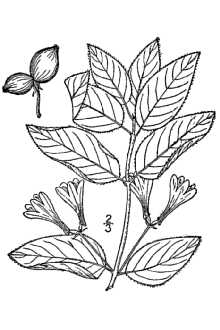American Fly Honeysuckle
Scientific Name: Lonicera canadensis W. Bartram ex Marshall

| General Information | |
|---|---|
| Usda Symbol | LOCA7 |
| Group | Dicot |
| Life Cycle | Perennial |
| Growth Habits | Shrub |
| Native Locations | LOCA7 |
Plant Guide
Use a soil moisture meter to monitor the soil moisture where American Fly Honeysuckle is planted.
Fact Sheet
Alternate Names
Canadian fly honeysuckle, Fly honeysuckle, Xylosteon ciliatum , Use soil moisture sensors to measure the soil moisture of American Fly Honeysuckle.
Uses
Current uses are primarily for the restoration of natural areas on National Park Service lands. American fly honeysuckle is a valuable pollinator support species, and should be incorporated in seeding mixtures for wildlife habitat and plant community diversification.
Status
Please consult the PLANTS Web site and your State Department of Natural Resources for this plant’s current status (e.g. threatened or endangered species, state noxious status, and wetland indicator values).
Description and Adaptation
Adaptation
Adaptation
American fly honeysuckle is a native perennial shrub that grows to about 2 meters (7.5 ft.) in height. It is loosely branched with slender twigs and spreads slowly. From April-July it flowers with yellow and whitish blooms; fruiting in July-Aug. It occurs in native woodlands and is readily located in many diverse eco-tones which include; rock outcrops, droughty gravels/rocky soils as well as marginal lowlands where soil is more moist and fertile. Fly honeysuckle seems to tolerate full sun to partially shaded sites.
Establishment
American fly honeysuckle roots readily from cuttings and is successfully propagated from seed. Plant materials were out-planted from nursery 1-quart and 1-gallon pots for plant community restoration. Plants from both sizes exhibited a high level of survival when out-planted in the spring and late spring months, and when standard guidelines for shrub plantings were followed.
Management
During the year of establishment, as with most shrubs, ensure adequate water is made available to the planting site. Also protect from mowers and traffic during the first year.
Pests and Potential Problems
This native shrub does not seem to exhibit any major damage from pests, disease or browse.
